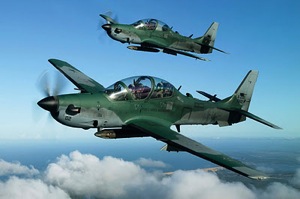2/25/11 By Ed Timperlake
In a practice air-to-air engagement, when one fighter closed on his opponent inside of the missile envelope to put the gun sight piper on the adversary, a call goes out “guns guns guns.” This is a blunt fighter pilot way of saying “your dead!”
In real life, the aircraft’s machine guns or cannons will do the actual “speaking” as this video from a shoot down in South America shows.
http://www.youtube.com/watch?v=gHDZqUa0m1s
This video shows the aggressive and very successful use of a Tucano, which now is in consideration for use in combat in Afghanistan.
There is currently a competition to provide for a Light Combat Aircraft for the Afghan forces being trained by the USAF. But is interesting to ask why does the USAF need a competition in any case, given that there is only one battle tested competitor flying today.
General Schwartz Chief of Staff of the Air Force has recently and forcefully stressed that industry should not be blowing smoke by laying off risk with over promising and sliding on delivery.
With that forceful philosophy it is amazing that the Super Tucano a proven aircraft isn’t already in Afghanistan.
The shoot down is a demonstration of versatility of the air-to-air capability of the Tucano, now upgraded to Super Tucano. For Afghanistan, the truly important combat reality is the Colombian Air Force is having noteworthy success in the air-to-ground attack mode (AG).

Before any further discussion of roles and missions for an Afghanistan “light attack” aircraft can proceed, various definitions of what is being discussed must be clarified.
The two planes in competition, a piloted turbo-prop like the AT-6 “Texan” and A-29 Super Tucano have been called a Light Attack Aircraft (LAA), a Light Attack Surveillance (LAS) aircraft and a Light Attack Armed Reconnaissance (LAAR) aircraft.
These distinctions only become important when discussing the names given by DOD for awarding various technology contracts.
For example, a recent fly off between the Hawker Beech AT-6 and Embraer Super Tucano to select the appropriate combat aircraft for the emerging Afghan Air Force is a “LAS competition.” However the fly off didn’t include dropping bombs or strafing because the AT-6 when going into the event wasn’t certified to drop bombs nor does it have an internal gun.
So if the AF Chief is talking about unnecessary risk-perhaps in this case physician heal they self.
The practical matter is the names (LAA, LAS/LAAR) are interchangeable when discussing the need for a piloted combat aircraft on the lower end of any airborne “hi-low” mix.
A piloted attack aircraft is also at least for now generally considered tactically above unmanned aerial systems (UAS). The current reason why the piloted aircraft is above UAS in capability is ‘eyes on” capability real time.
An airborne pilot is up close and personal with both sensors and combat teeth and is not fighting the battle from a computer consul half a world away.
Although, to be fair, some controllers are also closer to the action but still must operate through a data link.
One caveat that must always be acknowledged is that all airborne technology is relative and constantly evolving against a reactive enemy — so UAS may get better and begin to be substituted for any “hi-lo” piloted solution. But not anytime soon as a stay-behind force for the Afghan AF.
And there is still an open question yet to be determined on will UAS technology be more vulnerable “cyber attacks?” What also not mentioned much is that the UAS accident rate is significantly higher than piloted aircraft.
As far as piloted light attack — well respected warrior commanders with troops in combat — have been aggressively pursuing a light attack surveillance aircraft for the counter-insurgency role (COIN) in Afghanistan for quite some time.
General Mattis testified when he was head of Joint Forces Command)to the Senate.
A Light Attack Armed Reconnaissance (LAAR) aircraft capability has the potential to shift air support from a reactive threat response, to a more proactive approach that reduces sensor-to-shooter timelines, with immediate and accurate fires, providing surveillance and reconnaissance throughout a mission, while providing communication and navigation support to troops on the ground.
Additionally, a LAAR capability can provide a means to build partner capacity with effective, relevant air support.
This year Joint Forces Command will closely follow a project called Imminent Fury where the Navy and Air Force will employ a LAAR capability to reinforce our asymmetric advantage over the enemy.
Now General Mattis as Commander of Central Command is still concerned about bring a light attack aircraft to the fight.
As mentioned a “buy” of a squadron of LAS aircraft is in a current selection board for a stay behind combat force as the US and NATO allies draw down troop levels in our current fight against the Taliban.
This current source selection will hopefully be a full and fair selection process to avoid industry “risk” and thus really begin the significant transition to successfully put Afghanistan in the rear view mirror.
The initial positioning of a light attack aircraft in Afghanistan had been previously sabotaged by improper Congressional meddling because of domestic politics in the last Congress now becomes critical in “end game Afghanistan.”
Consequently, with a new Congress and a fresh start and an AF Chief who doesn’t want industry “smoke being blown,” perhaps the war fighters will finally get what they need –a totally capable combat proven light attack aircraft both for US special ops and the Afghan AF.
It is long past time for a pilot flying a light attack in Afghanistan to let the machine guns and cannons, and more AG ordinance say “guns guns guns” against the Taliban on the ground—“your dead!”
Re-posted August 3, 2014.

